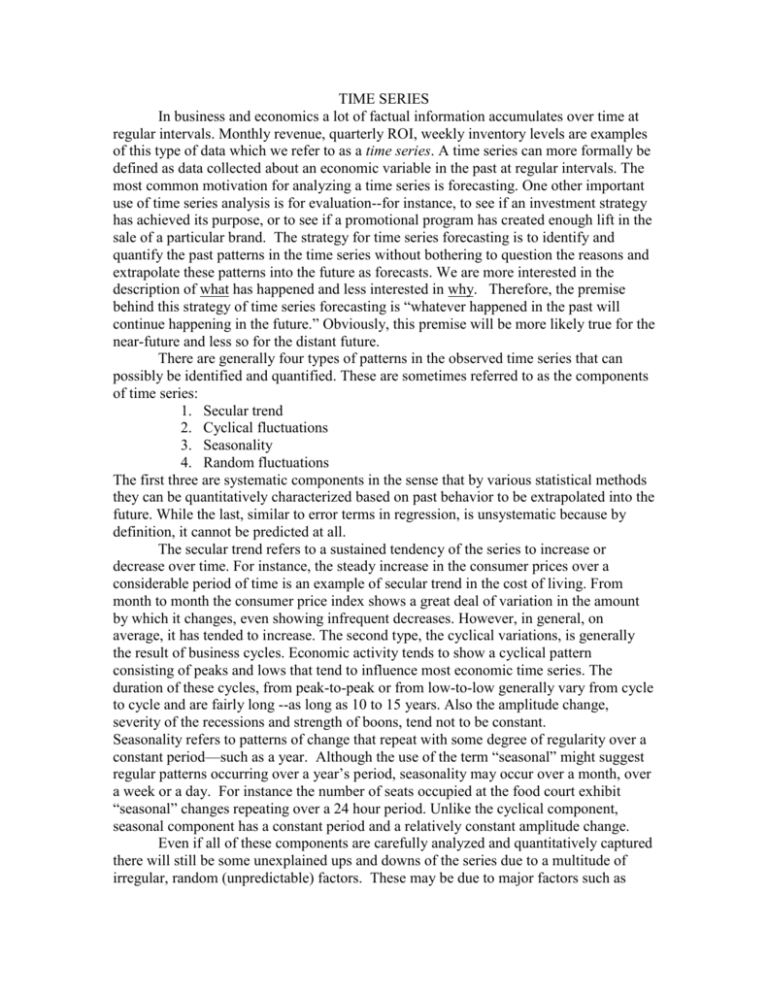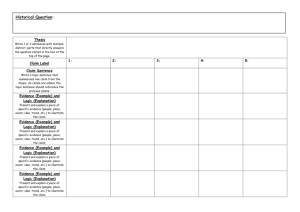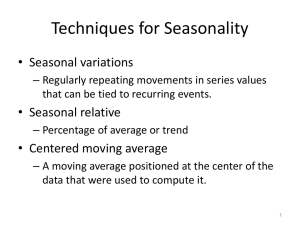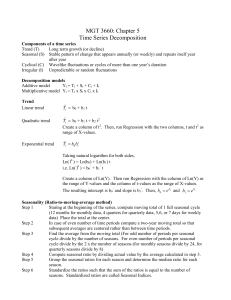time_series
advertisement

TIME SERIES In business and economics a lot of factual information accumulates over time at regular intervals. Monthly revenue, quarterly ROI, weekly inventory levels are examples of this type of data which we refer to as a time series. A time series can more formally be defined as data collected about an economic variable in the past at regular intervals. The most common motivation for analyzing a time series is forecasting. One other important use of time series analysis is for evaluation--for instance, to see if an investment strategy has achieved its purpose, or to see if a promotional program has created enough lift in the sale of a particular brand. The strategy for time series forecasting is to identify and quantify the past patterns in the time series without bothering to question the reasons and extrapolate these patterns into the future as forecasts. We are more interested in the description of what has happened and less interested in why. Therefore, the premise behind this strategy of time series forecasting is “whatever happened in the past will continue happening in the future.” Obviously, this premise will be more likely true for the near-future and less so for the distant future. There are generally four types of patterns in the observed time series that can possibly be identified and quantified. These are sometimes referred to as the components of time series: 1. Secular trend 2. Cyclical fluctuations 3. Seasonality 4. Random fluctuations The first three are systematic components in the sense that by various statistical methods they can be quantitatively characterized based on past behavior to be extrapolated into the future. While the last, similar to error terms in regression, is unsystematic because by definition, it cannot be predicted at all. The secular trend refers to a sustained tendency of the series to increase or decrease over time. For instance, the steady increase in the consumer prices over a considerable period of time is an example of secular trend in the cost of living. From month to month the consumer price index shows a great deal of variation in the amount by which it changes, even showing infrequent decreases. However, in general, on average, it has tended to increase. The second type, the cyclical variations, is generally the result of business cycles. Economic activity tends to show a cyclical pattern consisting of peaks and lows that tend to influence most economic time series. The duration of these cycles, from peak-to-peak or from low-to-low generally vary from cycle to cycle and are fairly long --as long as 10 to 15 years. Also the amplitude change, severity of the recessions and strength of boons, tend not to be constant. Seasonality refers to patterns of change that repeat with some degree of regularity over a constant period—such as a year. Although the use of the term “seasonal” might suggest regular patterns occurring over a year’s period, seasonality may occur over a month, over a week or a day. For instance the number of seats occupied at the food court exhibit “seasonal” changes repeating over a 24 hour period. Unlike the cyclical component, seasonal component has a constant period and a relatively constant amplitude change. Even if all of these components are carefully analyzed and quantitatively captured there will still be some unexplained ups and downs of the series due to a multitude of irregular, random (unpredictable) factors. These may be due to major factors such as wars, hurricanes, or due to random human behavior, or many unforeseen less significant events. Time Series Decomposition The approach employed to quantitatively characterize and capture the systematic components of a time series is called the process of time series decomposition. Literally, one tries to dissect the historical time series data into its systematic components by use of certain statistical methods in order to extrapolate these systematic components into the future in the form of forecasts. Again, by definition, the unsystematic component, random fluctuations (= residuals = noise) cannot be predicted. Identifying the Secular Trend The statistical tools for this purpose fall in two categories. There are various “smoothing” techniques which try to remove the rapid fluctuations in the series to reveal the secular trend. These are all based on some scheme of averaging of the data in an attempt to have the ups and downs to cancel one another. Moving averages and exponential smoothing are commonly used such techniques that you may have seen or will see in the Operations Management course. We will not discuss these smoothing techniques any further in this note. The second method is based on the use of a regression model to fit a line or a curve to the observed data to identify a linear or curvilinear secular trend. Linear trend A linear trend model assumes that the secular trend is constant and “additive” in the sense that the trend is YˆT YˆT 1 B for all T or YˆT YˆT 1 B. As can be seen from the last expression, it is assumed that the trend value, YˆT increases by a constant amount, B from any period T-1 to period T. The constant trend, B is estimated by fitting a linear line that considers time, T as the only independent variable, in the form of YT = A + BT + ε where YˆT is the value of the series at time T, A is the intercept which is the trend line value at time 0, B is the slope or the constant trend and ε is the unexplained random fluctuation. In estimating this model with a sample (a time series) although one can use the natural calendar times e.g., years as T, it is generally more convenient to code time as an offset from an arbitrary base. For example, instead of using 1996, 1997, . . . ,2007 as the T values, it is better taking, for instance 1995 as base (beginning of the series), and coding years 1996 through 2007 as 1 through 12. One advantage of this, besides easier arithmetic, is the interpretation of the intercept. Had we used the natural years as time, the intercept would have corresponded to the year Jesus was born! Since the period we take as our base is arbitrary, we can choose to code time in such a way that the sum of the coded time values becomes zero to further simplify the regression formulas used to estimate A and B. This can be achieved by selecting the base (T= 0) to be exactly at the mid-point of the time series. If we had an odd number of periods, say n = 7 (say 1990, 91, 92, 93, 94, 95 and 96 then T = 0 would have corresponded to 1993; and years 94, 95 and 96 would be coded as 1, 2, and years 92, 91,and 90 as -1, -2, and -3. However, if we had an even number of periods as in the example (n = 12), spanning the years from 1996 to 2007, the middle of the time series does not correspond to any of the years, but lines up with mid-point between years 2001 and 20021. Using this base we would code year 2002 as +.5 (half a year forward from the base), year 2003 as + 1.5, year 2001 as -.5, year 2000 as -1.5 etc. Remember that the formulas to compute an estimates of B and A, in simple 2 regression using T for X were b ( YT n Y T ) /( T n T 2) and a Y bT . Choosing T so that ΣT = 0 makes T 0 and the above formulas simplify to b = ΣYT/ΣT2 and a = ΣY/n = Y respectively which can easily be calculated even for a rather long series without the need for a computer. Of course, there is really no reason for not using standard regression packages (such as Excel’s regression tool) to estimate the trend line as an ordinary simple regression problem—one simply has to be careful in the interpretation of the output as a time series. Arbitrarily choosing the base (where T = 0) is equivalent to deciding where the vertical axis will be. To use the simpler formulas in the example, in the example we place the vertical axis at the mid-point between 2001 and 2002 and compute b = 196.535 and a = 1296.583. After obtaining these estimates with the simpler formulas, we can convert the estimated line for any other base rather easily. For instance in the example with T = 0 at mid-point between 2001 and 2002, the estimated trend equation is Y = 1296.583 + 196.535T. Suppose we want to obtain the equation of the trend line with T = 0 in year 1995 so that the observation years are 1, 2, 3, . . ,12. As is shown in the example where the vertical axis is placed has no effect on the slope; but the intercept must be converted so that it corresponds to the ordinate of the trend line when T = 0. Thus to find the intercept of the model with T = 0 in 1995, we have to go back 6.5 years (from mid-point of 2001-2002 to beginning of 1995). Therefore the appropriate intercept when 1995 is the base time (T = 0) is a’= a – 6.5*b = 1296.583 6.5* 196.535 = 19.106, so that the equation of the estimated line is Y = 19.106 + 196T if year 1995 is the base. As shown in the example, s can be computed by s (Yˆ Y ) 2 /( n 2) = 71.59 as a measure of the scatter of the observations around the estimated trend line. Additionally if it can be assumed that the residuals are indeed completely random and do not reflect any systematic component such as seasonality, it will have the properties of the se in ordinary regression analysis. However, most time series data the assumption of uncorrelated random errors is generally questionable; and errors tend to be serially correlated, e.g., the errors in successive periods tend to be correlated. There are formal tests such as Durbin-Watson discussed later, to check for serious serially correlated errors. In the example, assuming the residuals are indeed uncorrelated, then standard error of b, sb s 1 / T is valid and can be used to test if B = 0 ( no secular trend) or 2 any other value as well as constructing confidence intervals for B. To make forecasts for the future based on the extrapolation of the estimated line Y = 1296.583 + 196.535T, one simply extends the estimated line for T = 6.5 (for 2008), T =7.5 (for 2009) etc. Notice that this is against the advice in the use of regression: normally, we would be reluctant to make predictions of the response variable for values of the independent variable outside the range of it in the sample, yet this exactly what we 1 If we designate the end of year as Dec 31st of that year and number time periods by their end dates, the mid-point between years 2001 and 2002 would correspond to June 30, 2002. do by extending the trend equation into the future. If the presumption of the time series approach—“whatever happened in the past will continue in the future” holds, at least near-future, we have justification for using the projection of the estimated line as a point estimate (forecast) of the response variable. Because even when the assumption of uncorrelated error terms is violated, a and b remain unbiased estimators of A and B. However, any confidence interval is out of the question. Quadratic Trend In many economic time series the trend (change from period to period) does not remain constant as it does with linear model, but may change in a predictable way. For instance some series may exhibit a trend that may increase over time, or vice versa. A quadratic trend (function of T and T2) may be appropriate if the change in the trend remains constant. Mathematically, this corresponds to a situation where the second derivative of the trend line, d2Y/dT 2 is constant. A quadratic trend equation, Y = A + B1T + B2T 2 + ε has this property: dY/dT = B1 + 2B2T and d2Y/dT2= 2B2. The second derivative gives the rate of change of the first derivative (rate of change of Y). Thus from year to year the rate of change in Y changes by a constant amount 2B2. We can estimate a quadratic model by adding T2 as a second independent variable2. Although there are short-cuts similar to those for the linear model, we will rely on Excel in computation of the estimated parameters buy running it as a multiple regression model. In the example it is clear that a second order time series (quadratic) is a better fit than a linear trend by any criteria, most notably SSE. While in the linear model unexplained variation in Y, SSE is 22694.84, it is only 8355.379 (a 63% reduction) in the quadratic model. Log-Linear trend More often than not, in financial and economic data the trend is generally expressed as a percentage change. It is more common, for instance, to hear that housing starts in Winston Salem are growing at 5% per year rather than by 500 homes. This implies that the trend is multiplicative since YT is expressed as YT-1*1.05. This way of expressing trend has a very profound impact on the long term expected behavior of the response variable due to the force of compounding. To further illustrate the point consider 5% increase versus 5 point increase. Starting with 100 with 5% increase the response variable will be 105, 105*1.05 = 110.25, 110.25*1.05=115.76 etc. (each value in the series is obtained by multiplying the previous value by 1.05), while the annual increase of 5 will generate 100, 105, 110, 115 etc. (each value is obtained by adding 5 to the previous one) As you know, the impact of compounding can be very substantial over time. A time series suspected to exhibit such a compounding multiplicative trend cannot be adequately described by the linear trend model. A so-called log-linear model is more appropriate. The theoretical log-linear model is Y = eAeBTeε where e is the base of the natural logarithm or 2.718282. Fortunately this scary model can be easily estimated by taking the natural log of both sides—hence the name log-linear. This process yields lnY = A + BT + ε. Thus the estimation of the multiplicative model is obtained by a simple regression between the transformed dependent variable, lnY and time, T. In the example 2 The example keeps the original coding for time, though any other base could have been used since we are not using any simplified formula set. the estimated model is ln(Ŷ) = 3.160017 + .099411T which corresponds to Ŷ = e3.16*e.099411T. One interesting result of the use of this model is that the average constant percent change (multiplicative trend) is equal to eb – 1. In the example it is = e.099411 – 1 =.10452. Projection with the estimated model, regardless of which trend model is used, is done in exactly the same way. One simply evaluates the trend line at various future years by substituting the appropriate T values in the estimated line. In the log linear model, we can either substitute the T value in the linear line and obtain ln of our forecast and take the antilog; or directly evaluate the multiplicative model Ŷ = e3.16*e.099411T. Seasonality As discussed above, seasonality refers to a time series’ predictable behavior that repeat period after period. To capture this predictable behavior, we will introduce two approaches. The first approach, more common of the two, attempts to compute a set of seasonal indices that are used as multipliers to represent the seasonal variation compared to an “average” season. While a seasonal index of 1.00 represents an average period, an index of greater than 1.00 will describe a higher-than-normal season. In fact, an index of 1.15, for instance, characterizes a season 15% higher than an average season etc. Notice that the approach taken to the seasonal component is multiplicative—that seasonality impact is put on by multiplying an average season value by the appropriate seasonality index. A common approach to obtain seasonal indices is the method of ratio-to-movingaverages. With respect to a time series, a moving average is a simple arithmetic average of a fixed number of running observations. A four period moving average, for instance, averages the first four period’s observations, second through the fifth period’s observations, etc. Each moving average is obtained by dropping the least recent observation and adding a new one in the series. It is important to note that for a quarterly series, each four quarter moving average contains precisely one of each of the four quarters, thus averaging out the impact of seasonality. The idea of seasonal index is to extract seasonality effects by comparing the actual value of the series at some point in time to the moving average that is free from seasonal effects and attribute any discrepancy to the impact of seasonal forces. Look at the example to illustrate this procedure. The first four-quarter moving average is 107.55. We consider this to be representative of the state of affairs in the middle of year 1991 and thus associate this average value with the value of the series half way between the second and third quarters. Although this average is written in row 6 against quarter III, as the blue arrow points it actually represents the time series half way between quarters II and III. We can continue computing four-quarter moving averages by dropping one period from the previous average (quarter I of 91) and adding a new period, (quarter I of 92). The average, 119.74 is written in row 7 but represents the time series half way between quarters III and IV of 91. We calculate as many moving averages as we can—eventually we will run out of data. The next step is to “center” these moving averages so that they line up with actual quarters in our data. We do this by one more averaging step. Remember that the first moving average of 107.55 was representative of the half way between quarters II and III of 1991, while the second one, 119.74 lined up between quarters III and IV of the same year. Obviously the simple average of these two moving averages is a good value comparable to the actual observation in quarter III of year 1991. This step is called the “centering”3 of the moving averages (so that they are lined up with the actual observations in the time series) as shown in column E. Now we have actual observations in column C and centered moving averages starting with quarter III of 1991 through quarter II of 1994 in column E. The ratio of the actual observed value to the average can be taken as an estimator of the impact of seasonality. In the example, the actual divided by the corresponding centered moving average for quarter III of 1991 is .83376. This simply says that in 1991 quarter III observation was about 83.4 % of an average quarter at that point in time. We cannot, however, take this ratio as the seasonal index, and assume that every III quarter will be about 83.4% of a comparable average quarter because the actual observation at any T is also influenced by. It is possible that part of about 16.6% lower-than-average observation in quarter III of 1991 is due to some random occurrence and not a direct result of seasonality. To remove the impact of on these ratios as well as possible, we average the three such ratios available for each quarter. For instance, for quarter III we have ratios for years 1991, 1992 and 1993. These ratios are computed in column F with different color for each quarter; the average ratios for each of the three quarters are in row 25. One final step to obtain the seasonal indices is to normalize the ratios so that they average to 1.000 i.e., high seasons are completely counterbalanced by low seasons. This is done in row 26 where each index is obtained by dividing each average in row 25 by the average of averages in G25. It is often desirable to remove the impact of seasonality to more clearly see other systematic components, such as secular trend. Many economic data is published, for instance in WSJ, as seasonally adjusted exactly for this reason. The impact of seasonality can be removed from the data by dividing each observation by the appropriate seasonal index. For instance quarter I has a seasonal index of 1.0707 implying that a quarter I observation is about 7.07% higher than an average season. Thus taking the impact of seasonality from the time series value in QI of 1991 is tantamount to dividing the actual observed value by the seasonal index. This is done for all observations in column H to obtain deseasonalized series. Notice how much more smooth the deseasonalized data is, displaying the underlying trend much more clearly, compared to the actual observations. Forecasting with Trend and Seasonality Ignoring any cyclical component, it is clear that the deseasonalized Y in column H consists of trend and random fluctuations, ε. since we removed seasonality. Assuming linear trend (we could have assumed other models such as quadratic as well), it can be represented by Y = A + BT + ε. We can easily estimate this model with the simple regression formulas, if we code time as we have done in column B of “Forecasts” sheet. We obtain DesY = 178.16 + 12.0099T. Extending this line by inserting for T = 8.5, T =9 .5, etc. for any future period will give us a forecast of the deseasonalized Y. This is done in cells G26 through G33 for next eight quarters starting with quarter I of 1995. The final step is to adjust these seasonality-free forecasts by applying the seasonal indices captured earlier. Without seasonality (due to trend) we estimate Y for the first quarter of 1995 is 280.2423. However we know that quarter I is about 7% higher than-an-average- 3 Had we been computing moving averages with an odd number of periods, centering would not have been necessary. The moving average would naturally line up with the middle observation. quarter, thus our forecast for quarter I of year 1995 is 280.2423*1.0707 = 300.055. These forecasts are displayed in cells I26 through I33 in red. Dummy variables for seasonality This is another approach to incorporating trend and seasonality components in the analysis of a time series data. Although in the example we have assumed that the trend is linear in the form of Y = A + BT + ε, almost any other trend model can be used. Contrary to multiplicative seasonal index obtained with the moving averages method, with this model, the seasonality is also assumed to be an additive adjustment. Different seasons are considered as qualitative factors and are incorporated into the model with 0 or 1 dummy variables. In the example we have four seasons. Thus the seasonality as a qualitative variable will require precisely three dummy variables. One of the seasons, arbitrarily will be designated as the base season. Defining Q1, Q2, and Q3 as the seasonal dummy variables for quarters I through III (treating quarter IV as the base) leads to the model, Y = A + B1T + B2Q1+B3*Q2+ B4*Q3 + ε where the first two terms represent a linear trend and the last three components model the seasonal factors. The estimate of the coefficient of, say Q1, b2 gives the seasonal effect as a positive or negative adjustment to be added to the base quarter. In this case, quarter I is estimated to be a 44.71 units lower than quarter IV, etc. Forecasting with this model is done by simply extending the model into any future period complete with T and values of Q1, Q2 and Q3, as is done in the forecast column.







